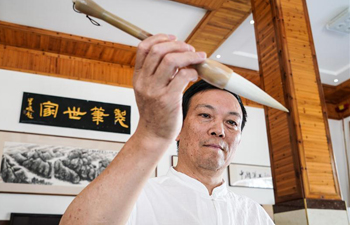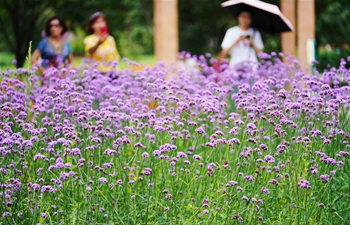JAKARTA, Aug. 9 (Xinhua) -- Seemingly indulging in their own painted creations, a clan of "special" people ignored those observing their activities in an arts gallery here.
At a glance, it would have looked as though this group of people were simply passionate about art. It might come as a surprise for passers-by to know that some people of the group were suffering from mental and other illnesses.
Using brushes and bare hands, they mixed colors from tubes of paint, and decorated pieces of canvas to express their sense of art. Some paintings looked just like masterpieces.
Some artists have been suffering from various kinds of mental disorders since birth. Their mental handicaps, in some cases, make them ostracized and alienated in society.
Sitting in a corner, a women in her late thirties named Daya Olivia Korompis was enthusiastically painting on a canvas with a brush. Her steady fingers guided the brush stroke by stroke and her painting of a panda was taking form.
"I like pandas because they are adorable animals. I also like to take care of animals, keeping them properly," Daya said.
She was among the nine mentally challenged people showing their drawing talent with other regular artists at a workshop held in the gallery.
Hari Bernadi, a caregiver to the "special group", said that painting was intentionally used as a therapy to help mental development and physical coordination skills.
"Painting activities, for example, can help skills in hands as well as hand-eye coordination," Hari told Xinhua, adding that painting also helps those with mental and learning difficulties to channel their inner emotions and express themselves in lieu of words.
By undertaking activities as painting, these people can express themselves which helps them to relax, said Hari.
Hari said the painting method used to teach the mentally-challenged people is pointillism, which is aimed at helping the participants to focus.
Katherina Lita Wewengkang, who co-founded the center to help people with mental illnesses, said that painting can serve as a therapy to help enhance hand-eye coordination and an awareness of objects.
Giving Daya as an example, she said that after attending painting therapy classes since she was nine-years-old, Daya now has the recognition and spatial awareness to move and place objects correctly.
"Daya's brain problem means she has a lack of awareness about objects around her. But painting really helps and now she can express herself through painting, which is a real boost to her self-confidence and her place in society," Katherina said.
While the therapy does not present a cure, it has certainly benefitted many participants, improving both mental and motor skills, as well as social skills.
Katherina said that many of the paintings produced by those with mental challenges here have gone on to be sold to collectors for decent prices.
"One of Daya's paintings was sold for 16 million rupiah (about 1,124 U.S. dollars) in a recent charity event," the co-founder of Jakarta's Daya Pelita Kasih center said.
An exhibition to display the group's paintings and related events aimed at empowering them by helping them become financially independent has been scheduled here later this month.
"I expect the exhibition would become an eye-opening event and help create more awareness in society about the existence of people with special needs and the valuable contributions they can make," Rina Ciputra, co-organizer of the exhibition, said.













